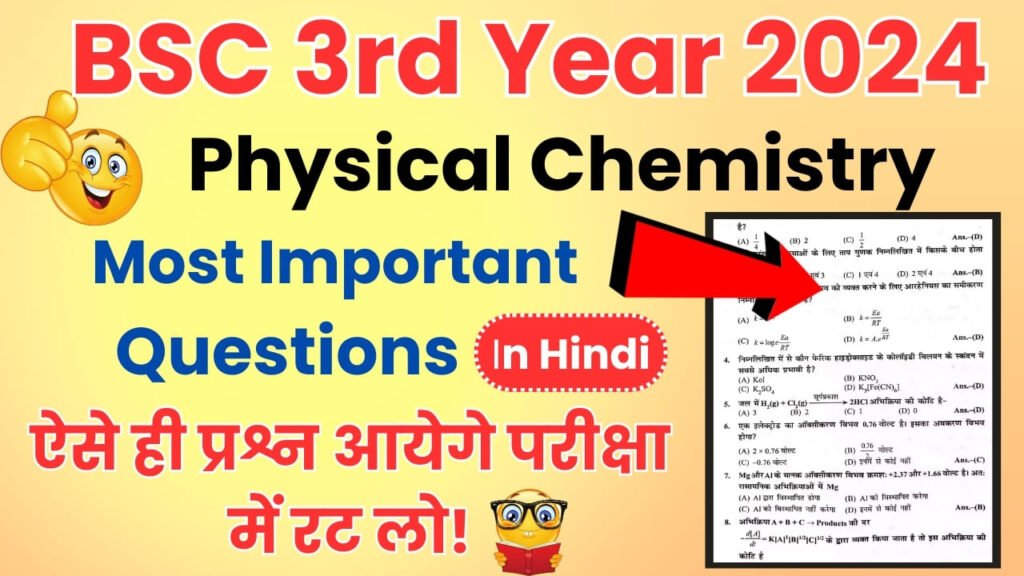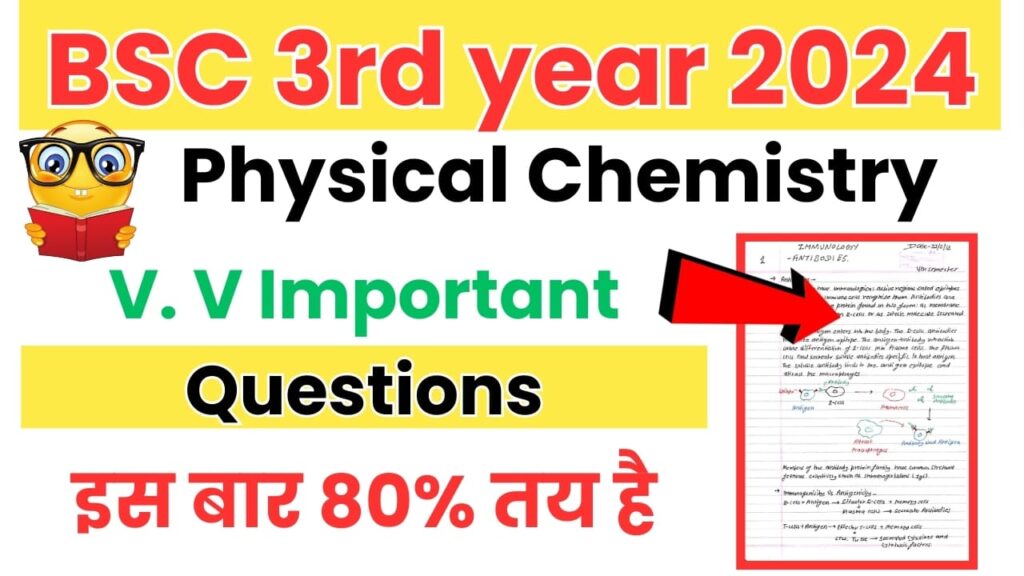नमस्कार साथियों क्या आप जानना चाहते है BSC 3rd Year Physical Chemistry Important Questions in Hindi 2024 के बारे में? दोस्तों आपका स्वागत है इस लेख में, हम आपको BSC 3rd Year Physical Chemistry Important Questions in Hindi के साथ BSC 3rd Year Physical Chemistry Important Questions in Hindi, BSC 3rd Year Physical Chemistry important questions 2024 के बारे में सब कुछ बताएंगे।

जैसा कि आप जानते हैं Chemistry एक बहुत ही दिमाग लगाने वाला subject है, तो इस लेख में हमने BSC 3rd Year Physical Chemistry Important Questions इकट्ठा किया है जो कि आपको पढ़ने में मदत करेंगे अगर आप इस लेख में बताए हुए Important Questions को एक बार रट लेंगे तो आप समझ लो 60% syllabus cover हो जाएगा, तो BSC 3rd Year Physical Chemistry Important Questions In Hindi की पूरी सूची पढ़ने के लिए इस लेख को अंत तक जरूर पढ़ें ।
यह BSC 3rd Year Physical Chemistry Important Questions के महत्वपूर्ण प्रश्न 2024 प्रतिष्ठित संस्थानों के अनुभवी शिक्षकों द्वारा तैयार किए गए हैं, इन प्रश्नों के पेपर में आने की अधिक संभावना है, इसलिए इन्हें अच्छी तरह से तैयार करें।
BSC 3rd Year Physical Chemistry Important Questions in Hindi

Q1: अश्लेषित तथा अश्लेषित उत्सर्जन प्रक्रियाओं के बीच क्या अंतर है? (Difference between Absorption and Adsorption processes)
Q2: गैसों के विभिन्न विधियों की ज्वलन ऊष्मा के आधार पर तुलना करें। (Comparison of different methods of measuring heat of gases)
Q3: सूक्ष्मद्रव्य की परिभाषा और उसके गुणों का विवरण कीजिए। (Definition and properties of colloids)
Q4: विलयन और वियुजन प्रक्रिया के बीच क्या अंतर है? (Difference between Fusion and Vaporization processes)
Q5: थर्मोडाइनामिक और अवस्थात्मक उत्सर्जन के मध्य क्या अंतर है? (Difference between Thermodynamic and State Adsorption)
Q6: वान दर विधि का परिभाषा और उसका उपयोग विस्तार से समझाएं। (Definition and applications of the Van der Waals equation)
Q7: उपसमस्याओं की परिभाषा और विभाजन के प्रकारों का वर्णन कीजिए। (Definition of Sub-problems and description of types of subdivision)
Q8: लांग्म्यूर इसोथर्म के बारे में विस्तृत विवरण प्रदान करें। (Detailed description of Langmuir Isotherm)
Q9: क्या आप जोमले संबंध की परिभाषा और मौलिक नियमों का वर्णन कर सकते हैं? (Can you define the Joule’s law and describe its fundamental rules?)
Q10: अधातु के ताप यानी मोलर उच्च ताप क्या है? (What is the heat of metal, i.e., molar heat capacity?)
Q11: बिना अंधकार के ज्वलन के लिए विभिन्न सूर्य के निकट ज्योतिष चिन्हों की परिभाषा और विवरण दें। (Define and describe various celestial symbols near the sun without eclipse.)
Q12: गैस में अनुच्छेदीय और असंघटित उत्सर्जन का अंतर क्या है? (What is the difference between paragraph and unorganized adsorption in a gas?)
Q13: संघटित वाष्पीय और असंघटित वाष्पीय क्षमता के बारे में विस्तार से वर्णन कीजिए। (Describe in detail the organized vapor and unorganized vapor capacity.)
Q14: बिंदु द्रव्यता के समरूपीकरण की परिभाषा और वर्णन करें। (Define and describe the isotherm of a point substance.)
Q15: विलयन और अपेक्षित उत्सर्जन प्रक्रियाओं के बीच क्या अंतर है? (What is the difference between fusion and expected emission processes?)
Q16: रासायनिक गतिविज्ञान में वान दर विधि का महत्व क्या है? (What is the importance of the Van der Waals method in chemical kinetics?)
Q17: उपसमस्याओं की परिभाषा और उनके प्रकार के बारे में विस्तृत वर्णन कीजिए। (Describe in detail the definition of sub-problems and their types.)
Q18: अश्लेषित तथा अश्लेषित उत्सर्जन प्रक्रियाओं के बीच क्या अंतर है? (What is the difference between absorption and desorption processes?)
Q19: थर्मोडाइनामिक और अवस्थात्मक उत्सर्जन के बीच क्या अंतर है? (What is the difference between thermodynamic and state adsorption?)
Q20: लांग्म्यूर इसोथर्म की परिभाषा और उसके लाभ का विवरण करें। (Define Langmuir Isotherm and describe its benefits.)
Q21: जोमले संबंध के सिद्धांत का विवरण करें। (Describe the principles of Joule’s relation.)
Q22: अधातु के ताप क्षमता क्या है? (What is the heat capacity of metal?)
Q23: सूर्य के बिना अंधकार के ज्वलन के लिए विभिन्न आसमानी चिह्न का विवरण कीजिए। (Describe various celestial symbols for solar burning without eclipse.)
Q24: गैस में अनुच्छेदीय और असंघटित उत्सर्जन के बीच अंतर क्या है? (What is the difference between paragraph and unorganized adsorption in gas?)
Q25: संघटित वाष्पीय और असंघटित वाष्पीय क्षमता का विवरण कीजिए। (Describe organized and unorganized vapor capacity.)
Q26: बिंदु द्रव्यता क्या है? (What is the point substance?)
Q27: विलयन और अपेक्षित उत्सर्जन प्रक्रियाओं के बीच अंतर क्या है? (What is the difference between fusion and expected emission processes?)
Q28: रासायनिक गतिविज्ञान में वान दर विधि का महत्व क्या है? (What is the importance of the Van der Waals method in chemical kinetics?)
Q29: अश्लेषित और अश्लेषित उत्सर्जन की परिभाषा क्या है? (What is the definition of absorption and desorption?)
Q30: थर्मोडाइनामिक और अवस्थात्मक उत्सर्जन के बीच अंतर क्या है? (What is the difference between thermodynamic and state adsorption?)
Also Read:
- BSC 3rd Year Organic Chemistry Important Questions in Hindi 2024! ऐसे ही प्रश्न आयेगे परीक्षा में रट लो!
- BSC 3rd Year InOrganic Chemistry Important Questions in Hindi 2024! ऐसे ही प्रश्न आयेगे परीक्षा में रट लो!
- BSC 2nd Year InOrganic Chemistry Important Questions in Hindi 2024! ऐसे ही प्रश्न आयेगे परीक्षा में रट लो!
हमें उम्मीद है कि इस लेख की मदद से आपको BSC 3rd Year Physical Chemistry Important Questions in Hindi के बारे में जानकारी मिल गई होगी।
दोस्तों आपको यह पोस्ट कैसी लगी कृपया हमें कमेंट सेक्शन में बताएं और यदि आपके कोई प्रश्न हों तो बेझिझक हमसे Comment Box में पूछ सकते हैं। यदि आपको यह पोस्ट उपयोगी लगी तो कृपया इसे दूसरों के साथ साझा करें।